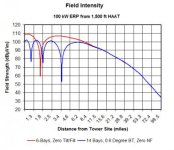everydayguy
Frequent Participant
Ok, I'll admit I'm mostly a programming guy trying to learn more about broadcast engineering -- so forgive my question if it sounds dumb, but here goes:
If hypothetical FM station "Z" is authorized as a non-directional C3 with 13kw ERP at 450 feet HAAT, is there any advantage to the signal to having fewer bays on the FM antenna and greater transmitter output power?
Or is there an advantage to having less transmitter output power and more bays (more gain)--or is it a wash?
In other words in this example: A 5 kw transmitter with a six bay antenna at 450 feet? Or a 10 kw transmitter with fewer bays at 450 feet? Either configuration would need to equal 13kw ERP.
By "advantage", I'm referring only to the signal strength - does one configuration or the other provide a signal that travels farther, a signal with less multipath, or a signal that penetrates buildings better?
Thanks!
If hypothetical FM station "Z" is authorized as a non-directional C3 with 13kw ERP at 450 feet HAAT, is there any advantage to the signal to having fewer bays on the FM antenna and greater transmitter output power?
Or is there an advantage to having less transmitter output power and more bays (more gain)--or is it a wash?
In other words in this example: A 5 kw transmitter with a six bay antenna at 450 feet? Or a 10 kw transmitter with fewer bays at 450 feet? Either configuration would need to equal 13kw ERP.
By "advantage", I'm referring only to the signal strength - does one configuration or the other provide a signal that travels farther, a signal with less multipath, or a signal that penetrates buildings better?
Thanks!


